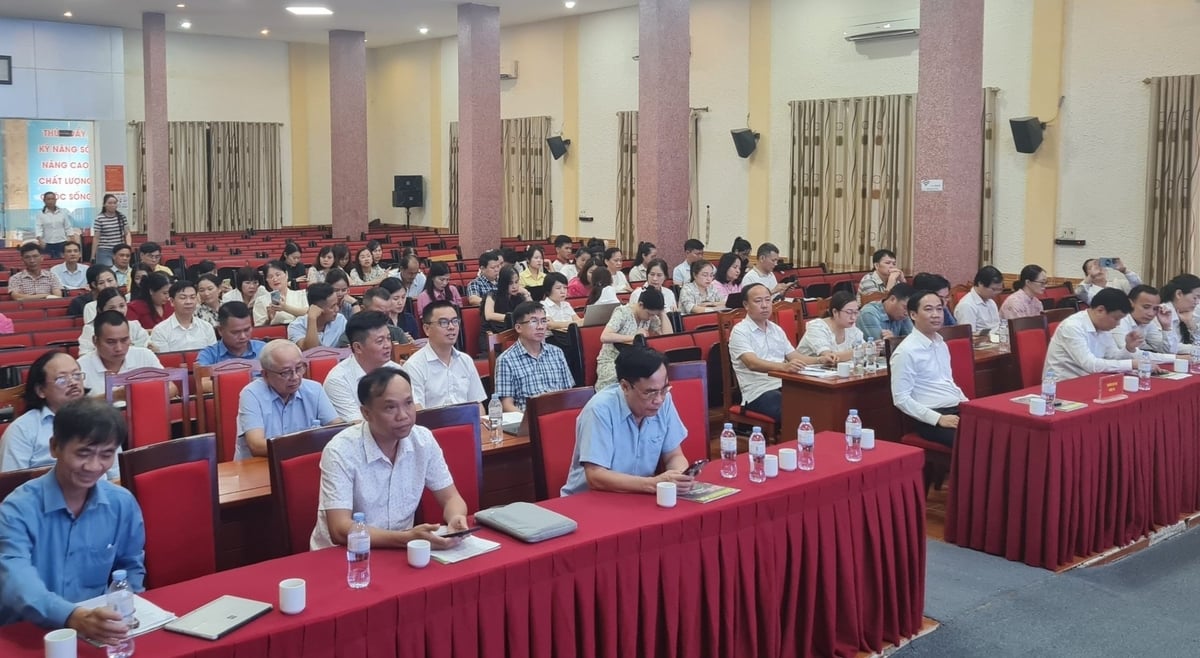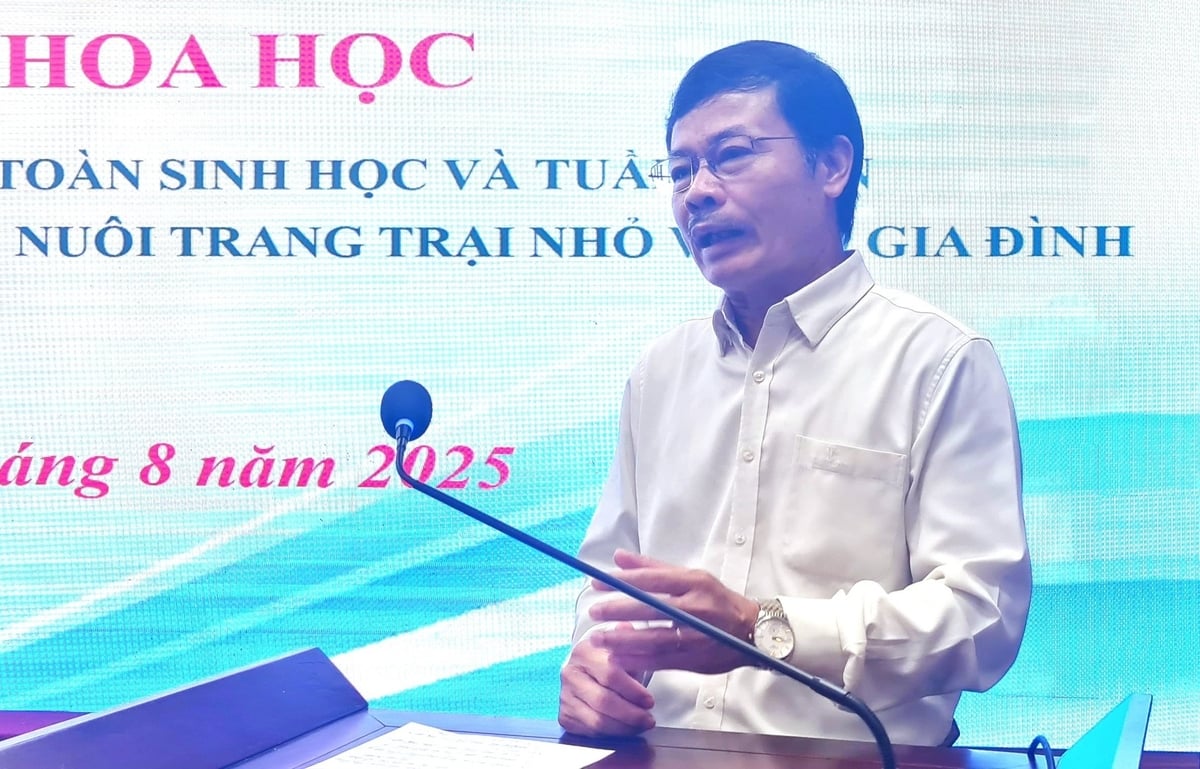December 23, 2025 | 12:43 GMT +7
December 23, 2025 | 12:43 GMT +7
Hotline: 0913.378.918
December 23, 2025 | 12:43 GMT +7
Hotline: 0913.378.918
On August 15 in Nghe An, the Vietnam Union of Science and Technology Associations, in collaboration with the Vietnam Livestock Association and the Nghe An Union of Science and Technology Associations, organized a scientific workshop titled “Applying biosecure and circular farming practices to enhance production efficiency in small-scale and household farms”.

The workshop, ‘Applying biosecure and circular farming practices to enhance production efficiency in small-scale and household farms', provided practical solutions. Photo: Viet Khanh.
According to statistics, the country's total livestock population includes approximately 571 million poultry (ranking second in Southeast Asia), 30 million pigs (ranking sixth globally), 6.29 million cattle, and 2.07 million buffalo. There are 48,622 farms (3,481 large-scale, 16,041 medium-scale, and 2,910 small-scale), 267 facilities for producing complete industrial compound animal feed, and 440 centralized slaughterhouses (under control).
Livestock farming is a key sector with stable growth. Positive signs continued to be evident in the first half of 2025, as demonstrated by many key indicators meeting or exceeding targets: the pig population increased by 3.6% (reaching 27.07 million), the poultry population grew by 3.5% (reaching 584.33 million), industrial animal feed production rose by 1.16% (reaching 8.7 million tons), live hog prices increased by 10-12%, and livestock product exports grew by 11.7%.

The participation of powerful corporations like TH Group has elevated the livestock sector's profile in Nghe An and nationwide. Photo: Viet Khanh.
These achievements are the result of an increasingly completed institutional framework (the Law on Livestock, the Law on Veterinary Medicine, the Law on Food Safety, and various guiding decrees and circulars), the Prime Minister's approval of the Livestock Development Strategy for the 2022-2030 period with a vision to 2045, and the strong promotion of policies on genetics, environment, and disease prevention.
Small-scale and household farming is declining rapidly, while the quality of breeds has improved significantly. Biotechnology is applied in 100% of large-scale farms, and international standards such as Global GAP and ISO 9001 are being adopted (by companies like TH Milk, Vinamilk, Dabaco, CP, and Mavin).
Based on this data, Mr. Nguyen Xuan Duong, Chairman of the Vietnam Livestock Association, affirmed: "The livestock sector has had a brilliant development journey. Over 30 years of integration and development, it has made many breakthroughs and now fundamentally meets the consumption needs of the Vietnamese people through key products like meat, milk, and eggs. Livestock farming has made a particularly important contribution to the overall development of the agricultural sector”.

Mr. Nguyen Xuan Duong affirmed that the livestock sector has made a significant contribution to the development of the entire industry. Photo: Viet Khanh.
While these achievements are recognized, the national livestock sector also faces challenges from fluctuations in the global feed market. Small-scale, household farming still accounts for a high percentage, the organization of livestock production is not yet synchronized, and the complex nature of epidemics poses a high risk of disease outbreaks.
In Nghe An, there are nearly 1,000 farms classified under the Law on Livestock (37 large-scale, 340 medium-scale, and the rest small-scale). The province also has over 167,000 households raising cattle and buffalo (averaging 2-3 head per household), nearly 127,000 households raising pigs (7-10 per household), 187,891 households raising poultry (averaging 150-200 per household), and 25,391 households engaged in other forms of livestock farming.

Many biosecure and circular farming models in Nghe An are yielding high efficiency. Photo: Viet Khanh.
The Nghe An Sub-Department of Livestock Production and Veterinary Medicine believes that applying biosecure farming is the key to repelling diseases. A synchronized approach to technical measures for breeding, housing, feed, and water, along with proper care, veterinary hygiene, waste treatment, and disease management, will help prevent and minimize the spread of pathogens.
A survey found that most large-scale farms in Nghe An are doing an excellent job of applying biosecurity measures. In addition, about 70% of medium and small-scale farms and 50% of household farmers are also quite effectively applying biosecure practices.

The biosecurity and circular economy model is seen as an effective solution for Nghe An, where household farming accounts for a high percentage. Photo: Viet Khanh.
Meanwhile, the development of livestock farming under the circular economy model has created a major turning point for Nghe An, thanks to the simultaneous participation of leading enterprises such as TH Food Chain Joint Stock Company, Vietnam Dairy Products Joint Stock Company (Vinamilk), Minh Loi Agricultural Cooperative, and Dien Trung Agricultural Cooperative.
Translated by Linh Linh

(VAN) As Viet Nam enters a new era, the national agricultural sector must proactively adapt to global trends to transform current challenges into strategic development opportunities.
/2025/12/18/5046-3-154320_307.jpg)
(VAN) Granting planting area codes is a solution that helps Lao Cai manage forests effectively while also laying a data foundation to support the development of the carbon credit market in the future.
/2025/12/16/3554-1-192458_116.jpg)
(VAN) Minister Tran Duc Thang held a working session with the Viet Nam Seaculture Association to discuss solutions for developing marine farming in a methodical, industrial, sustainable, and well-organized manner.

(VAN) Trading forest carbon credits is to reduce greenhouse gas emissions while creating sustainable livelihoods for local communities.

(VAN) Expanding the area of forests with FSC certification creates a foundation for elevating the economic value of forests, promoting sustainable management, and offering opportunities to participate in the carbon credit market.

(VAN) MAE and GIZ organized the conference to strengthening capacity and readiness for EUDR implementation in Vietnam.

(VAN) When women, men, children, and people with disabilities all have the opportunity to maximize their potential, the economy will grow, and the country will prosper.